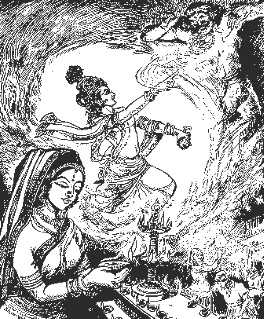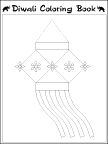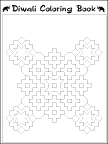Balagokulam Guide
Festivals
Biographies
Hindu Dharma
Other Topics
Sangh Prarthana
Ekata Mantra
Shlokas
Bhajans
Sangh Geet
Skits
|
|
Aashwayuja Krishna Chaturdashi To Kaartika Shukla Dwiteeyaa
(The 14th Day of the dark half of Aashwayuja to the 2nd day of bright half of Kaartik)
View presentation on Deepavali (ppt 1.8 MB)

If there is one occasion which is all joy and all jubilation for one and all - the young and the old, men and women for the entire Hindu world, it is Deepavali - the Festival of Lights. Even the humblest of huts will be lighted by a row of earthen lamps. Crackers resound and light up the earth and the sky. The faces of boys and girls flow with a rare charm in their dazzling hues and colors. Illumination - Deepotsavas – in temples and all sacred places of worship and on the banks of rivers symbolize the scattering of spiritual radiance all round from these holy centers. The radiant sight of everybody adorned with new and bright clothes, especially women decorated with the best of ornaments, captures the social mood at its happiest.
And all this illumination and fireworks, joy and festivity, is to signify the victory of divine forces over those of wickedness.
 After the slaying of Narakaasura, Sri Krishna bathed himself smearing his body with oil in the early morning of Chaturdashi. Hence the invigorating vogue of taking an early morning `oil-bath' on that day. After the slaying of Narakaasura, Sri Krishna bathed himself smearing his body with oil in the early morning of Chaturdashi. Hence the invigorating vogue of taking an early morning `oil-bath' on that day.
Mother Earth, whose son Narakaasura was, requested Sri Krishna that the day be celebrated as one of jubilation. Sri Krishna granted the request and since then the tradition has continued. Mother Earth reconciled herself to the loss of her son and knowing as she did that the Lord had punished her son for the sake of the welfare of the world, she set a glowing example of how one has to brush aside one's personal joys and sorrows in the interest of society. It is this deliverance of the people from the clutches of the asuras that fill the people with joy.
Then follows Amaavaasya, the new moon day, auspicious for offering prayers and gratitude to the bygone ancestors of the family and invoking their memories and blessings for treading the path of right conduct. This is also the sacred occasion for the worship of Lakshmi, the goddess of Wealth and Prosperity. The business community open their New Year's account with Her worship. This reminds us of the famous saying of the sage Vyaasa, ' dharmaadarthashcha kaamashcha...' - it is through right conduct that wealth and fulfilment of desires also accrue.
Go to top
The third day, i.e., the first day of Kaartik, is named Balipratipada, after the demon king Bali, the ruler of Paataala ( the netherworld ), who had extended his kingdom over the earth also. On that day, Sri Vishnu, taking the form of a dwarfish Brahmin by name Vaamana, approached Bali, for a boon of space equal to his three steps. Bali, known for his charity, gladly granted the boon. Vaamana now grew into a gigantic form; with one step he covered the entire earth, with the second he covered the outer sky, and asked Bali where he should keep his third step. Bali, left with no other choice, showed his own head. Sri Vishnu placed his foot on Bali's head and pushed him down to the netherworld. However, Bali prayed to the Lord that he might be permitted to visit the earth once a year. Now it was the turn of Vishnu to grant the boon. And the people too offer their and respect to him on this day.
The annual visit of Bali is celebrated in Kerala as Onam. It is the most popular festival for Kerala where every Hindu home receives him with floral decorations and lights and festoons adorn all public places. Onam, however, falls on the 16th day of Aavani ( Sowramaana ) in September.
The pratipada is also the day for Govardhana Pooja and Anna Koota ( heap of grains ), the former signifying the Govardhana episode in Sri Krishna's life and the latter conveying affluence and prosperity.
The fourth and final day is Yama Dwiteeya, also called Bahu beej. It is a most touching moment for the family members when even distant brothers reach their sisters to strengthen that holy tie. The sister applies tilak and waves aarati to her brother, and the brother offers loving presents to the sister.
To the Jains, Deepavali has an added significance to the great event of Mahaaveera attaining the Eternal Bliss of Nirvaana. The passing into Eternity on the same Amaavaasya of Swami Dayananda Saraswati, that leonine sanyasin who was one of the first to light the torch of Hindu Renaissance during the last century, and of Swami Ramatirtha who carried the fragrance of the spiritual message of Hindu Dharma to the western world, have brought the national-cum-spiritual tradition of Deepavali right up to modern times.
Lets try coloring some stuff which are done exclusively for Deepavali.
Click on the image and take a printout and start coloring
 
Back to Festivals
Go to top
|
|

